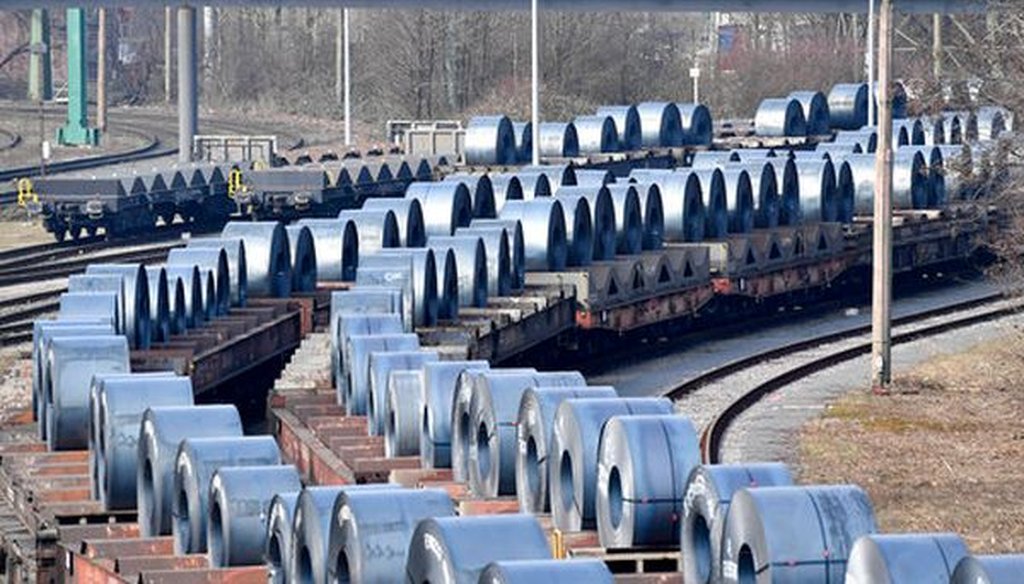

Our only agenda is to publish the truth so you can be an informed participant in democracy.
We need your help.


Steel coils sit on wagons when leaving a steel factory in Germany on March 2, 2018, as the U.S. was considering tariffs on steel and aluminum imports. (AP/Martin Meissner)
As President Donald Trump weighed imposing tariffs on foreign steel and aluminum, some commentators have warned that this would be a misguided approach.
Noah Smith, a columnist for Bloomberg View and a former finance professor, wrote a column in which he noted, among other things, that a crucial issue facing metals-producing industries isn’t foreign competition — it’s automation.
Tariffs, Smith wrote, won’t "bring back good jobs at steel and aluminum factories. Since 1990, production of metals in the U.S. has held roughly constant, but the number of people employed in the industry has fallen steadily."
That’s due to technological improvements, he wrote: "Productivity has improved, even as demand has stayed more or less constant. Mathematically, that means fewer jobs for steel and aluminum workers. Tariffs won’t change that equation. If anything, by hurting downstream industries like car and equipment manufacturers, the new import taxes will probably kill more factory jobs than they save."
We can’t predict what will happen in the future, but we wondered whether Smith is right about the trend lines for production and employment in the American metals-producing sector since 1990. And when we took a closer look, we found that he’s on target.
We found data for employment in the primary metals-producing sector, which incorporates five subcategories: iron and steel mills, steel product manufacturing from purchased steel, aluminum production and processing, production and processing of metals other than iron and aluminum, and foundries.
Employment levels in this sector have declined reasonably steadily since 1990, despite a period of stable employment during the late 1990s, a sharp but temporary fall during the Great Recession, and a modest uptick over the past year or two in which metals employment growth has outpaced that of the overall economy, said Jed Kolko, chief economist at the jobs site Indeed.com.
Overall, since 1990, employment has declined by about 42 percent.
At the same time, production in primary metals has remained roughly the same since 1990 except for the Great Recession. For most of that period, production has ranged between 90 percent and 110 percent of the benchmark level (the amount produced in 2012):
If you put these two statistics together, the overall pattern becomes clear: As production stays roughly the same and as fewer workers make it happen, productivity rises over time.
The idea that steel in particular has experienced a productivity revolution due to technology "is the same story I have been telling since the early 1990s," said Gary Burtless, an economist with the Brookings Institution. "The basic story is that one person can produce a lot more metal today than he or she could produce" a few decades ago.
Burtless said he has a brother who’s been working in the coke oven of a steel plant since the mid 1970s and who has "seen first-hand the dramatic reduction in person-power needed to keep integrated steel mills running at full capacity" — as well as improvements in quality.
Michael J. Hicks, the director of the Center for Business and Economic Research at Ball State University, agreed that Smith’s analysis is on target.
"I would agree that the most likely cause of the productivity gains are technology, though I would interpret technology broadly to include not just machinery but the way that factories organize production, such as internal logistics and the reduction of redundant operations that might be enabled by technology," Hicks said.
And J. Bradford Jensen, a professor of international business at Georgetown University’s McDonough School of Business, added that "imports did have something to do with the loss of employment in steel and aluminum, but the more important factor is technological change and productivity growth," he said.
"Tariffs won't change that, much like relaxing regulations on coal and pollution will not bring back many coal-mining jobs," he said.
Smith wrote, "Since 1990, production of metals in the U.S. has held roughly constant, but the number of people employed in the industry has fallen steadily."
His numbers are solid, and experts agree that automation has done significant harm to employment levels in the metal industry. We rate the statement True.
Noah Smith, "Trump's Tariffs Look Like a Self-Inflicted Wound," March 7, 2018
Bureau of Labor Statistics, employment in the primary metals sector, accessed March 7, 2018
Bureau of Labor Statistics, index page for primary metals sector and subsectors, accessed March 7, 2018
Federal Reserve Board, industrial production for primary metals, accessed March 7, 2018
Bureau of Labor Statistics, productivity for the primary metals sector, accessed March 7, 2018
Indeed.com, "Steel, Aluminum Tariffs and Jobs: What Could Happen?" March 7, 2018
Email interview with Jed Kolko, chief economist at the jobs site Indeed.com, March 7, 2018
Email interview with Gary Burtless, senior fellow with the Brookings Institution, March 7, 2018
Email interview with Michael J. Hicks, director of the Center for Business and Economic Research at Ball State University, March 7, 2018
Email interview with J. Bradford Jensen, professor of international business at Georgetown University’s McDonough School of Business, March 7, 2018
In a world of wild talk and fake news, help us stand up for the facts.
